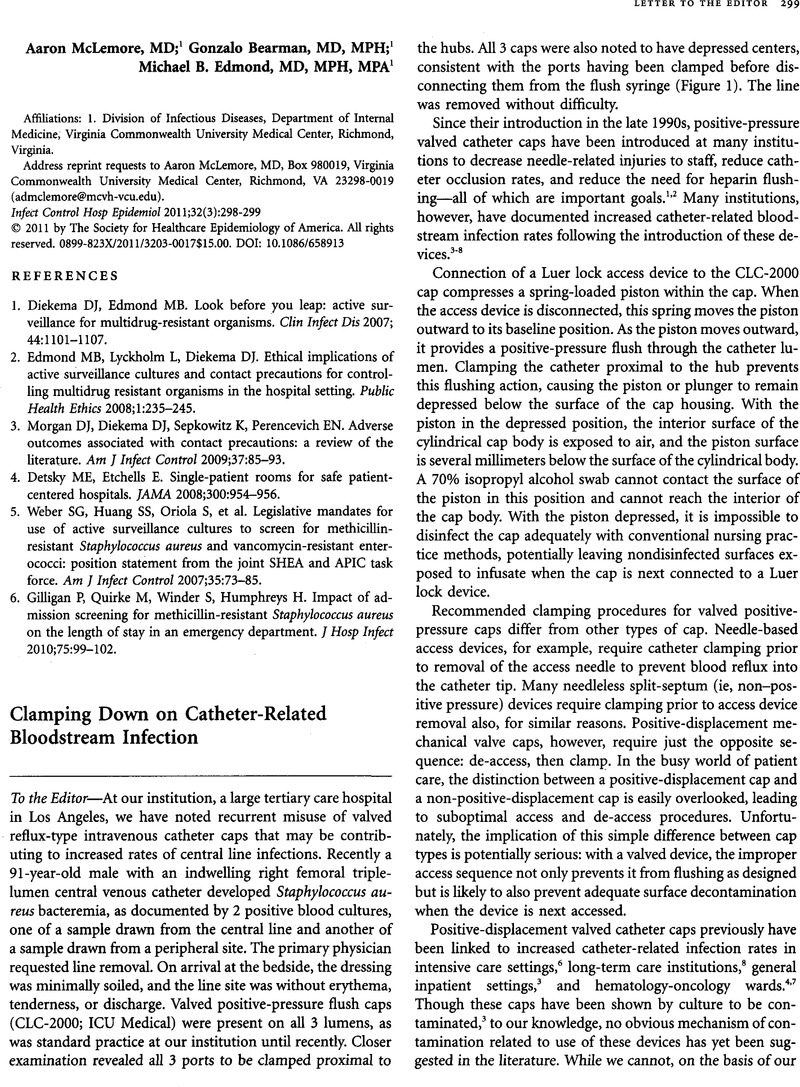No CrossRef data available.
Article contents
Clamping Down on Catheter-Related Bloodstream Infection
Published online by Cambridge University Press: 02 January 2015
Abstract
An abstract is not available for this content so a preview has been provided. As you have access to this content, a full PDF is available via the ‘Save PDF’ action button.

- Type
- Letters to the Editor
- Information
- Copyright
- Copyright © The Society for Healthcare Epidemiology of America 2011
References
1.Benson, JS. FDA safety alert: needlestick and other risks from hypodermic needles on secondary I.V. administration sets—piggyback and intermittent I.VXSS Food and Drug Administration. Rock-ville, MD: Public Health Service, 1992. http://www.fda.gov/downloads/MedicalDevices/Safety/AlertsandNotices/PublicHealthNotifications/ucm063115.pdf. Accessed October 8, 2010.Google Scholar
2.US Congress. Needlestick safety and prevention act. HR 5178. Washington, DC: Government Printing Office, 2000. http://frwebgate.access.gpo.gov/cgi-bin/getdoc.cgi?dbname =106_cong_public_laws&docid = f:publ430.106.Google Scholar
3.Rupp, M, Sholtz, L, Jourdan, D, et al.Outbreak of bloodstream infection temporally associated with the use of an intravascular needleless valve. Clin Infect Dis 2007;44:1408–1414.CrossRefGoogle ScholarPubMed
4.Field, K, McFarlane, C, Cheng, A, et al.Incidence of catheter-related bloodstream infection among patients with a needleless, mechanical valve-based intravenous connector in an Australian hematology-oncology unit. Infect Control Hosp Epidemiol 2007;28:610–613.CrossRefGoogle Scholar
5.Maki, DG, Kluger, DM, Crnich, CJ. The risk of bloodstream infection in adults. Mayo Clin Proc 2006;81(9):1159–1171.Google Scholar
6.Maragakis, L, Bradley, K, Song, X, et al.Increased catheter-related bloodstream infection rates after the introduction of a new mechanical valve intravenous access port. Infect Control Hosp Epidemiol 2006;27:67–70.CrossRefGoogle ScholarPubMed
7.Toscano, CM, Bell, M, Zukerman, C. Gram-negative bloodstream infections in hematopoetic stem cell transplant patients: the roles of needleless device use, bathing practices, and catheter care. Am J Infect Control 2009;37(4):327–334.CrossRefGoogle Scholar
8.Saigado, CD, Chinnes, L, Paczesny, TH, Cantey, JR. Increased rate of catheter-related bloodstream infection associated with use of a needleless mechanical valve device at a long-term acute care hospital. Infect Control Hosp Epidemiol 2007;28:684–688.Google Scholar
9.Ryder, M, Fisher, S, Hamilton, G, et al.Bacterial transfer through needlefree connectors: comparison of nine different devices. In: Program and abstracts of the 17th Annual Scientific Meeting of the Society for Healthcare Epidemiology of America; April 14-17, 2007; Baltimore, MD, 2007. Abstract 210.Google Scholar
10.Menyhay, SZ, Maki, DG. Disinfection of needleless catheter connectors and access ports with alcohol may not prevent microbial entry: the promise of a novel antiseptic-barrier cap. Infect Control Hosp Epidemiol 2006;27:23–27.Google Scholar




